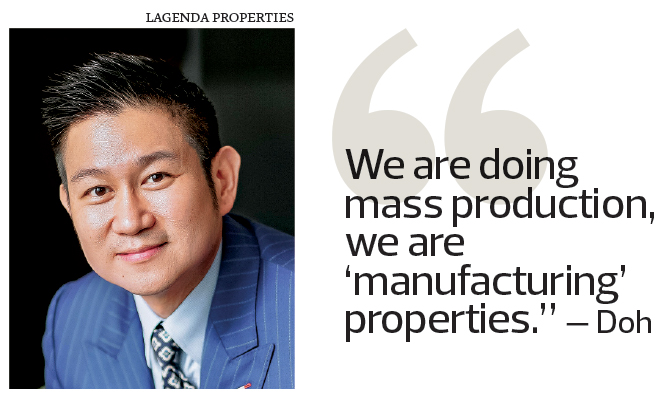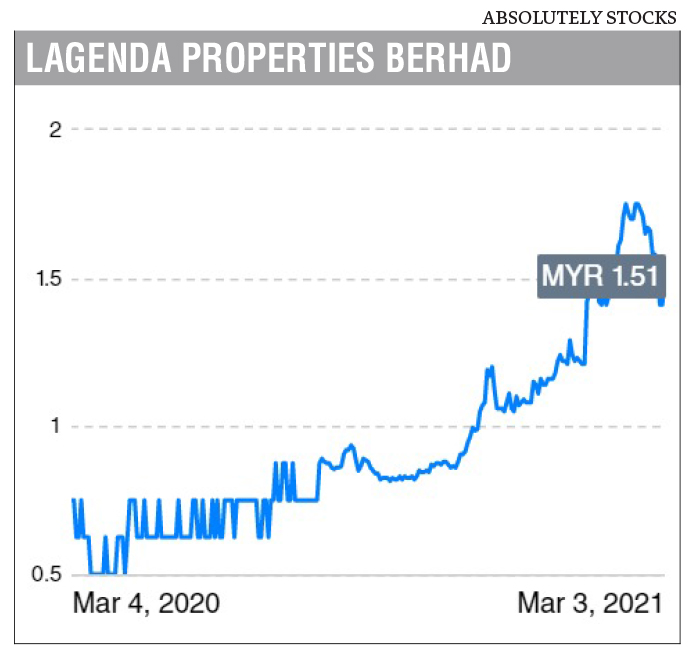
Lagenda plans to launch one township project a year, with a GDV of up to RM2 billion. (Photo by Lagenda Properties)
This article first appeared in The Edge Malaysia Weekly on March 8, 2021 - March 14, 2021
LITTLE is known about Lagenda Properties Bhd, but the Perak-based firm is one of the most profitable property developers listed on Bursa Malaysia. With a market capitalisation of RM1.24 billion, it is in the ranks of high-end developers such as Eco World Development Group Bhd and Tropicana Corp Bhd.
According to its group managing director Datuk Jimmy Doh Jee Ming, the transformation of Lagenda — formerly known as DBE Gurney Resources Bhd — was completed in August last year.
Following the emergence of the Doh family as new major shareholders, the poultry business of DBE has been sold back to the Ding family, the previous owners who had gradually exited the company. Today, Lagenda is a pure-play property developer specialising in affordable housing.
“To me, this is only the beginning. Today, our presence is mostly in Perak. We still have so many other states to go into,” Doh tells The Edge in a virtual interview.
“Kedah is next. We hope to launch a few township projects there. The B40 (bottom 40% income group) market is huge. Our numbers can get even better in the coming years.
“Our sales target is RM1 billion for this year, and we hope to achieve 20% to 30% more on a yearly basis. We are quite certain that we can sell about RM300 million each for our three township projects.”
Lagenda’s net profit increased 18 times year on year to RM140.9 million in the financial year ended Dec 31, 2020 (FY2020). Excluding one-off expenses for corporate exercises and other non-operational expenses, the group generated an operating profit of RM185 million last year.
Considering that Lagenda’s affordable housing projects have largely escaped the brunt of the Covid-19 pandemic and the Movement Control Order (MCO), Doh is confident that the group can maintain its growth momentum and that its financial performance will be reflected clearer and better in FY2021.
“Based on our projects in the pipeline, Lagenda should be able to generate profit growth for years to come. On average, we are talking about RM50 million in operational profit on a quarterly basis. Due to the accounting standards disclosure requirements, there may be some variance,” he says.
Lagenda has two ongoing major township developments in Perak — Bandar Baru Setia Awan Perdana and Lagenda Teluk Intan. This year, the group plans to launch its third township project in Tapah, on land that it purchased from UEM Sunrise Bhd last year.
Lagenda plans to launch its fourth township project in Sungai Petani, Kedah, next year. Moving forward, all of its projects will carry the Lagenda name, so the newest developments will be called Lagenda Tapah and Lagenda Sungai Petani.
“The project in Sungai Petani is a joint venture with Bina Darulaman Bhd, where they are the landowner and we are the developer. We do not purchase the land outright. This is favourable to us as it means less upfront capital investment and better cash flow management,” Doh explains.
Ideally, Lagenda plans to launch one township project a year, with a gross development value (GDV) of RM1.5 billion to RM2 billion, which should keep the group busy for the next five years, he adds.
Lagenda’s total remaining GDV is about RM3.5 billion, mainly from Bandar Baru Setia Awan Perdana (launched in 2016), Lagenda Teluk Intan (launched in 2018) and the upcoming Lagenda Tapah.
‘Our houses are affordable, so are our shares’
It is worth noting that most, if not all, of Lagenda’s residential units are affordable. For instance, all of its units in Perak are selling at less than RM200,000 each, which is within the range of house prices under the Rumah Perakku guidance. “Our main objective is really to provide a roof over people’s heads. If you compare us with other high-end property developers, they tend to have different identities for different projects. They need different people to execute different ideas. But for us, our team is focused on doing almost the same thing, executing the same designs and themes for different projects,” says Doh.
He adds that Lagenda has to ensure that its cost remains low so that the group can continue to maintain its pricing at a range that is within the reach of most Malaysians. “We need to work harder than our competitors to stay ahead of the curve. We are doing mass production, we are ‘manufacturing’ properties, and we have the economies of scale to drive costs down. The idea is that we just keep doing the same thing again and again, but get better and better.”
The Doh family is the controlling shareholder of Lagenda, with 74.5% equity interest. Institutional investors have an 8.5% stake while retail investors hold the remaining 17%.
When asked whether Lagenda is being held too tightly by his family, Doh says he does not mind roping in strategic partners who can collaborate with the major shareholder. “We plan to expand our business and presence across the country as soon as we can. Put it this way, I am saving my shares for our potential strategic partners one day.”
Still, it remains to be seen if Doh can deliver on his promises.
He concedes that not many people have heard of Lagenda. However, as the group expands its presence outside Perak, it should be able to gain better exposure.
Lagenda’s share price had advanced 71.6% over the last six months to close at RM1.51 last Wednesday.
“Generally, I think the investors believe in us and they like our growth story. I would like to think that our products are affordable, the land we buy is affordable. And if you look at our share price, it is also quite affordable currently,” says Doh.
He urges investors to look at Lagenda differently from other property counters, considering that the group’s business model is based on “use the least money to make the most money”. “If you look at our housing prices over the past five years, including the pandemic year in 2020, they have increased steadily each year. That means our profitability still has upside on the increment in housing prices. But if you look at other developers, they have been giving discounts and rebates, which affect their profitability.”
Doh also says Lagenda is committed to paying out 25% to 30% of its profits as dividends. “This is not a formal dividend policy though. We will continue to reward our shareholders. We are still very much a growth stock, but we will try to be as generous as we can.”
Save by subscribing to us for your print and/or digital copy.
P/S: The Edge is also available on Apple's App Store and Android's Google Play.
- BYD unveils battery system that charges an EV in five minutes
- MRCB strikes land deals with MOF unit
- Is Trump economically clueless and stupid? Tong's Portfolio does not think so.
- MRCB, Sapura Energy, Solarvest, Salcon, Rohas Tecnic, HHRG, Jentayu, Focus Point, Catcha Digital, Poh Huat, Dutch Lady, AmanahRaya REIT
- Police grill Malaysian who head-hunted for Myanmar syndicate, say not all rescued are genuine victims
- Creative Technology cuts workforce, adding to global wave of tech layoffs - report
- Pimco turns more negative on German bonds ahead of debt vote
- Volkswagen's Audi to cut 7,500 jobs in administration, development by 2029
- Asia Poly disposes of entire stake in Ta Win
- OECD warns of tariff drag on growth as Trump vows to press on with levies


